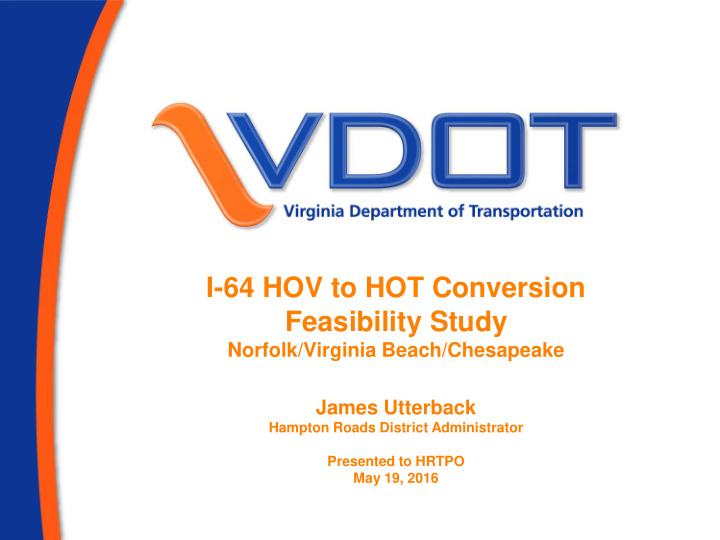



I-64 HOV to HOT Conversion Feasibility Study Norfolk/Virginia Beach/Chesapeake James Utterback Hampton Roads District Administrator Presented to HRTPO May 19, 2016
I-64 HOV to HOT Conversion Feasibility Study Regional Opportunity • 32 miles of HOV lanes in Hampton Roads are underused • Opportunity to provide travel choices to reduce traffic congestion by using the underused HOV lanes • Improve reliability and reduce congestion in both general purpose and HOV travel lanes Objective • Determine the feasibility of converting portions of the existing HOV network to HOT lanes • Identify the potential benefits and implications of a HOV to HOT conversion 2
Study Scope The study will evaluate I-64 HOV lanes on the Southside from I-564 to Battlefield Boulevard. First Segment: I-564 to I-264 • 8.4 miles of two-lane reversible HOV lanes Second Segment: I-264 to Battlefield Boulevard • 6.0 miles of dual direction one-lane HOV (diamond) lanes 3
Study Scope -- Location Map 4
I-64 HOV to HOT Conversion Solutions– Three Initial Policy Choices HOV/HOT Occupancy Requirements • HOT 2+ or HOT 3+ HOT Hours of Operation • 2 hours in both the AM and PM peak period* *Includes HOT operation in off-peak • 4 hours in both the AM and PM peak period* direction on Segment 2 • 24 hour operation HOT Days of Operation • Weekday only • Weekends 5
I-64 HOV to HOT Conversion – Two Initial Pricing Policy Choices Pricing Methodology • Time of day pricing (pre-defined rate schedule) • Dynamic pricing (toll rates based on traffic flow) Pricing Strategy • Transaction based • Trip based 6
Four Elements Define Feasibility Improved corridor throughput and reduced congestion in the general purpose lanes • Build condition travel speeds compared to no-build scenario Revenues generated by HOT lanes exceed cost of operations • Operations and Maintenance costs covered in year 1 • Capital costs paid back over 30 years or less Design layout of toll infrastructure feasible • Lane configuration and geometry supports conversion of HOV to HOT HOT solution has flexibility to support potential future managed lane segments 7
Feasibility Assessment Relative to Benchmarks Segment 1 is feasible • HOT2+ • 4 hours in both the AM and PM peak • Weekday only • Dynamic Pricing • Transaction-based * may be feasible, pending further study, if combined Segment 2 is not feasible financially* with managed lanes on High-Rise Bridge • HOT2+ • 4 hours in both the AM and PM peak and non-peak • Weekday only • Dynamic Pricing • Transaction-based 8
Benefits Segment 1 • Average utilization during 2 Hour AM & PM HOV restricted periods • AM: 1603 (existing), 4325 (2018), 4825 (2034) • PM: 2348 (existing), 5275 (2018), 5725 (2034) • GP utilization decreases 17% - 20% due to shifts to HOT • Free flow capacity = 6000+ vehicles (1,500 vehicles / lane x 2 lanes x 2 hours) Segment 2 • Utilization during 2 Hour AM & PM HOV restricted periods • AM: 1335 (existing), 2315 (2018), 2805 (2034) • PM: 1651 (existing), 2450 (2018), 2925 (2034) • GP utilization decreases 3% - 10% due to shifts to HOT • Free flow capacity = 3000+ vehicles (1,500 vehicles / lane x 1 lane x 2 hours) 9
Next Steps Finalize study report - June for Segments 1 and 2 Assess integration of High Rise Bridge managed lane segment on traffic operations and revenue • VDOT operation • MOT and timing of procurement and construction Request regional support through HRTPO Develop Implementation Plan to include design, construction and operation 10
Recommend
More recommend